Analysis of Asset Revaluation and Its Effects on Financial Reporting
VerifiedAdded on 2019/10/30
|10
|2541
|167
Report
AI Summary
This report provides a comprehensive analysis of asset revaluation, a process where the value of an asset is adjusted to reflect its market value. It explores the characteristics of revaluation, its recognition in equity, and its impact on financial statements, including the income statement and balance sheet. The report also discusses the motivations behind revaluing assets and the implications of not revaluing assets on shareholder wealth, referencing IAS 16. It examines the effects of revaluation on key financial metrics such as ROE and ROA. Furthermore, the report delves into the valuation criteria, including cost and revaluation models, and the application of financial costs. The report includes a case study of Amcor Ltd, examining its Plant, Property, and Equipment (PPE) and the impact of revaluation on its financial position.
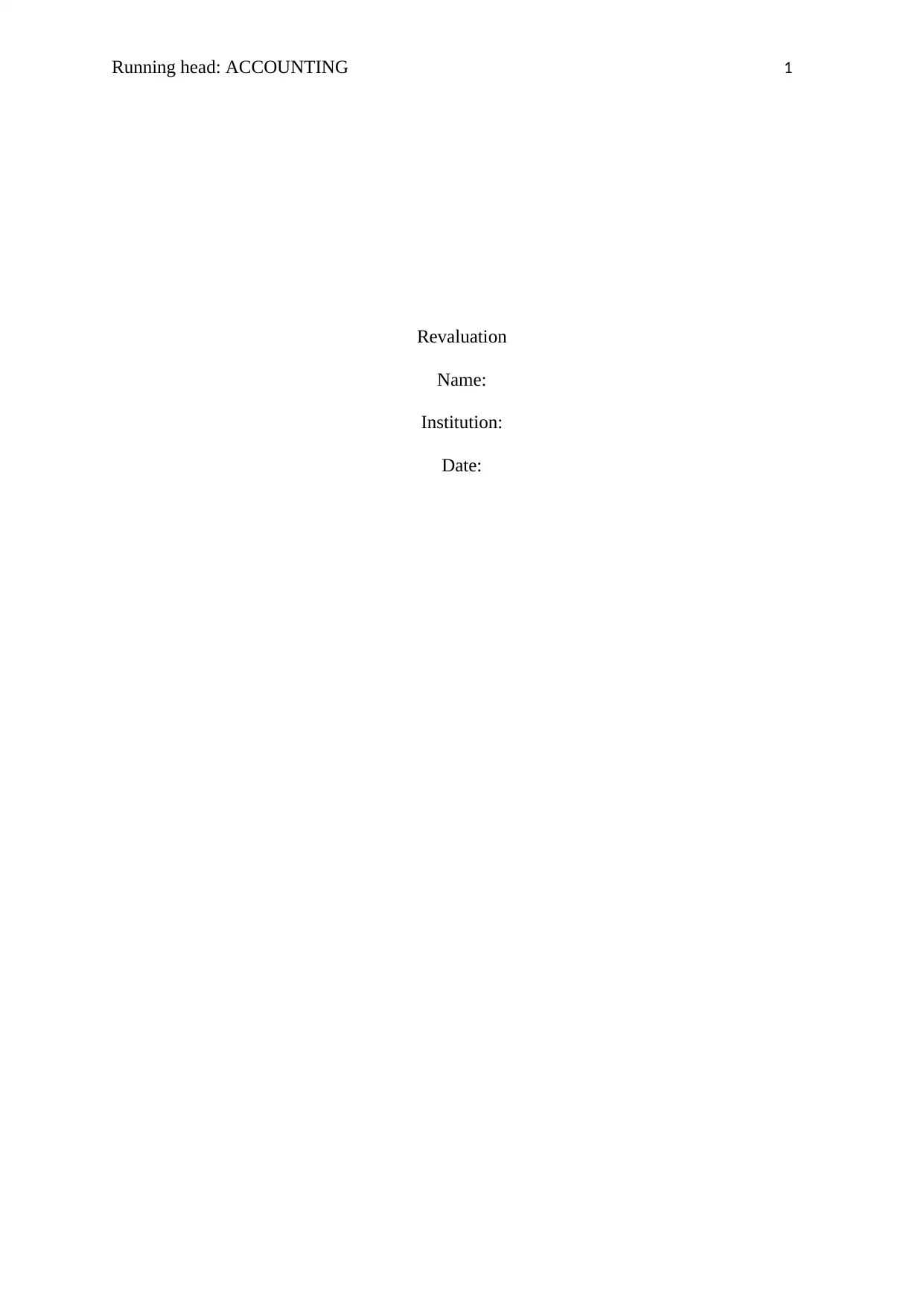
Running head: ACCOUNTING 1
Revaluation
Name:
Institution:
Date:
Revaluation
Name:
Institution:
Date:
Paraphrase This Document
Need a fresh take? Get an instant paraphrase of this document with our AI Paraphraser
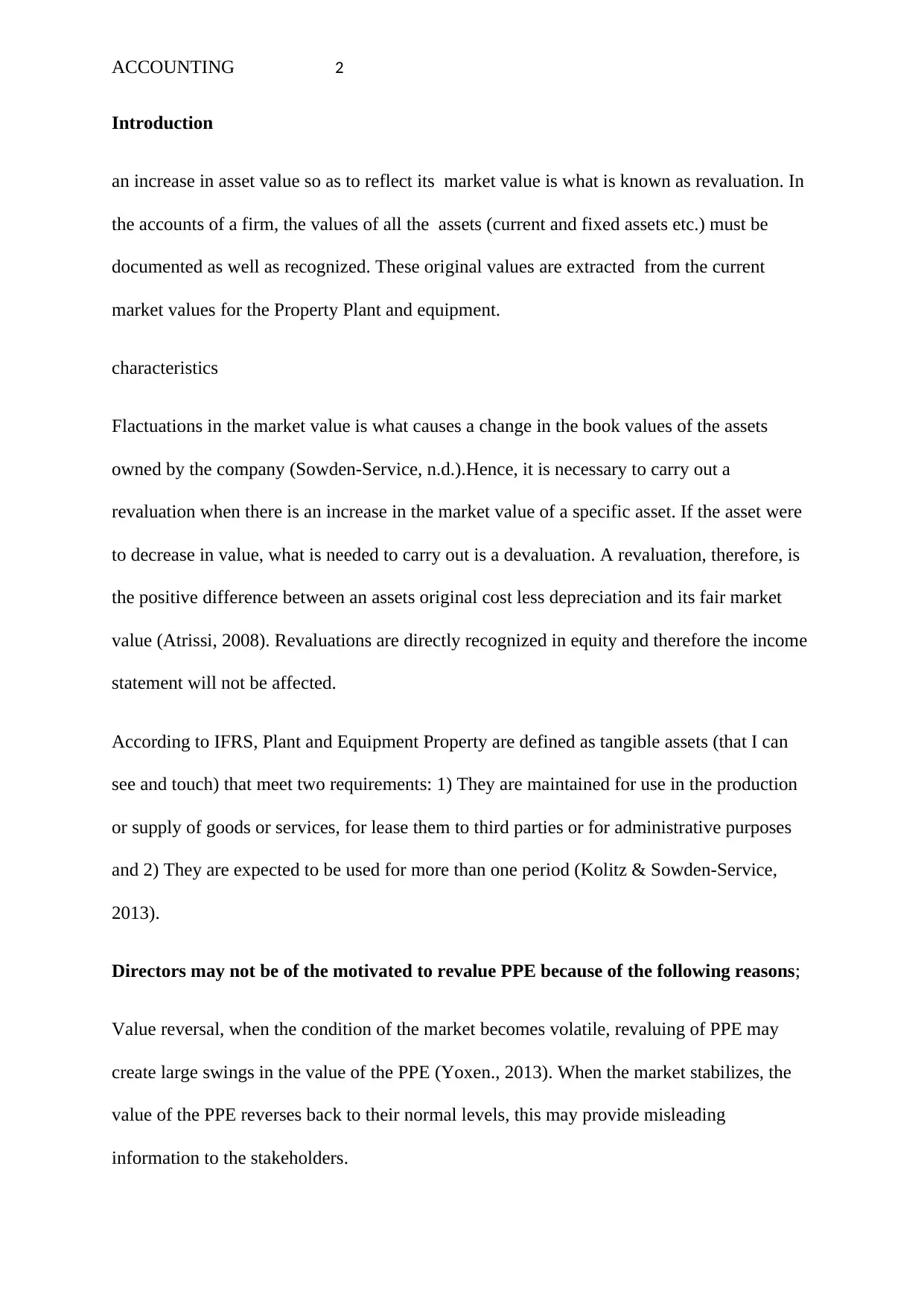
ACCOUNTING 2
Introduction
an increase in asset value so as to reflect its market value is what is known as revaluation. In
the accounts of a firm, the values of all the assets (current and fixed assets etc.) must be
documented as well as recognized. These original values are extracted from the current
market values for the Property Plant and equipment.
characteristics
Flactuations in the market value is what causes a change in the book values of the assets
owned by the company (Sowden-Service, n.d.).Hence, it is necessary to carry out a
revaluation when there is an increase in the market value of a specific asset. If the asset were
to decrease in value, what is needed to carry out is a devaluation. A revaluation, therefore, is
the positive difference between an assets original cost less depreciation and its fair market
value (Atrissi, 2008). Revaluations are directly recognized in equity and therefore the income
statement will not be affected.
According to IFRS, Plant and Equipment Property are defined as tangible assets (that I can
see and touch) that meet two requirements: 1) They are maintained for use in the production
or supply of goods or services, for lease them to third parties or for administrative purposes
and 2) They are expected to be used for more than one period (Kolitz & Sowden-Service,
2013).
Directors may not be of the motivated to revalue PPE because of the following reasons;
Value reversal, when the condition of the market becomes volatile, revaluing of PPE may
create large swings in the value of the PPE (Yoxen., 2013). When the market stabilizes, the
value of the PPE reverses back to their normal levels, this may provide misleading
information to the stakeholders.
Introduction
an increase in asset value so as to reflect its market value is what is known as revaluation. In
the accounts of a firm, the values of all the assets (current and fixed assets etc.) must be
documented as well as recognized. These original values are extracted from the current
market values for the Property Plant and equipment.
characteristics
Flactuations in the market value is what causes a change in the book values of the assets
owned by the company (Sowden-Service, n.d.).Hence, it is necessary to carry out a
revaluation when there is an increase in the market value of a specific asset. If the asset were
to decrease in value, what is needed to carry out is a devaluation. A revaluation, therefore, is
the positive difference between an assets original cost less depreciation and its fair market
value (Atrissi, 2008). Revaluations are directly recognized in equity and therefore the income
statement will not be affected.
According to IFRS, Plant and Equipment Property are defined as tangible assets (that I can
see and touch) that meet two requirements: 1) They are maintained for use in the production
or supply of goods or services, for lease them to third parties or for administrative purposes
and 2) They are expected to be used for more than one period (Kolitz & Sowden-Service,
2013).
Directors may not be of the motivated to revalue PPE because of the following reasons;
Value reversal, when the condition of the market becomes volatile, revaluing of PPE may
create large swings in the value of the PPE (Yoxen., 2013). When the market stabilizes, the
value of the PPE reverses back to their normal levels, this may provide misleading
information to the stakeholders.
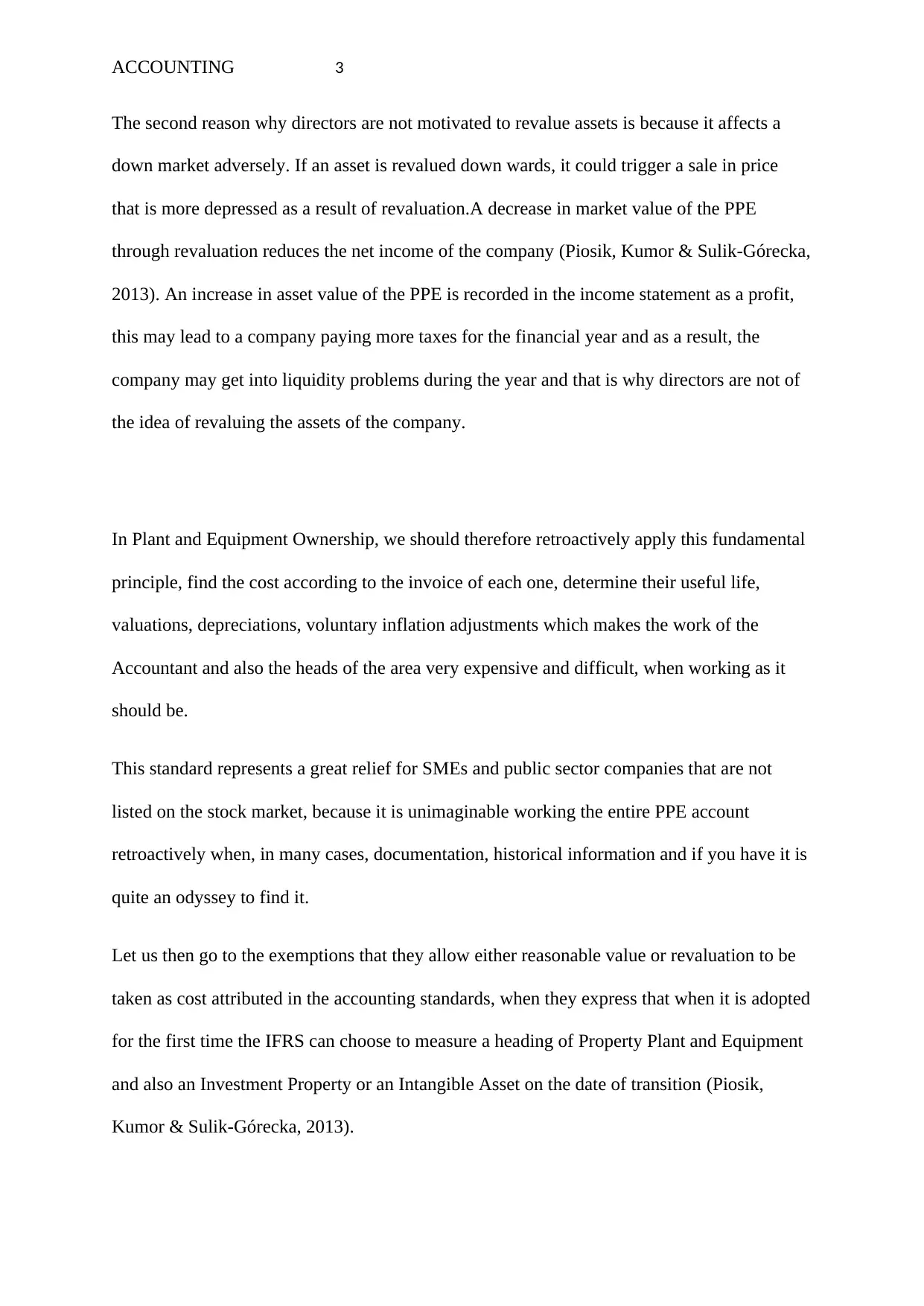
ACCOUNTING 3
The second reason why directors are not motivated to revalue assets is because it affects a
down market adversely. If an asset is revalued down wards, it could trigger a sale in price
that is more depressed as a result of revaluation.A decrease in market value of the PPE
through revaluation reduces the net income of the company (Piosik, Kumor & Sulik-Górecka,
2013). An increase in asset value of the PPE is recorded in the income statement as a profit,
this may lead to a company paying more taxes for the financial year and as a result, the
company may get into liquidity problems during the year and that is why directors are not of
the idea of revaluing the assets of the company.
In Plant and Equipment Ownership, we should therefore retroactively apply this fundamental
principle, find the cost according to the invoice of each one, determine their useful life,
valuations, depreciations, voluntary inflation adjustments which makes the work of the
Accountant and also the heads of the area very expensive and difficult, when working as it
should be.
This standard represents a great relief for SMEs and public sector companies that are not
listed on the stock market, because it is unimaginable working the entire PPE account
retroactively when, in many cases, documentation, historical information and if you have it is
quite an odyssey to find it.
Let us then go to the exemptions that they allow either reasonable value or revaluation to be
taken as cost attributed in the accounting standards, when they express that when it is adopted
for the first time the IFRS can choose to measure a heading of Property Plant and Equipment
and also an Investment Property or an Intangible Asset on the date of transition (Piosik,
Kumor & Sulik-Górecka, 2013).
The second reason why directors are not motivated to revalue assets is because it affects a
down market adversely. If an asset is revalued down wards, it could trigger a sale in price
that is more depressed as a result of revaluation.A decrease in market value of the PPE
through revaluation reduces the net income of the company (Piosik, Kumor & Sulik-Górecka,
2013). An increase in asset value of the PPE is recorded in the income statement as a profit,
this may lead to a company paying more taxes for the financial year and as a result, the
company may get into liquidity problems during the year and that is why directors are not of
the idea of revaluing the assets of the company.
In Plant and Equipment Ownership, we should therefore retroactively apply this fundamental
principle, find the cost according to the invoice of each one, determine their useful life,
valuations, depreciations, voluntary inflation adjustments which makes the work of the
Accountant and also the heads of the area very expensive and difficult, when working as it
should be.
This standard represents a great relief for SMEs and public sector companies that are not
listed on the stock market, because it is unimaginable working the entire PPE account
retroactively when, in many cases, documentation, historical information and if you have it is
quite an odyssey to find it.
Let us then go to the exemptions that they allow either reasonable value or revaluation to be
taken as cost attributed in the accounting standards, when they express that when it is adopted
for the first time the IFRS can choose to measure a heading of Property Plant and Equipment
and also an Investment Property or an Intangible Asset on the date of transition (Piosik,
Kumor & Sulik-Górecka, 2013).
⊘ This is a preview!⊘
Do you want full access?
Subscribe today to unlock all pages.

Trusted by 1+ million students worldwide
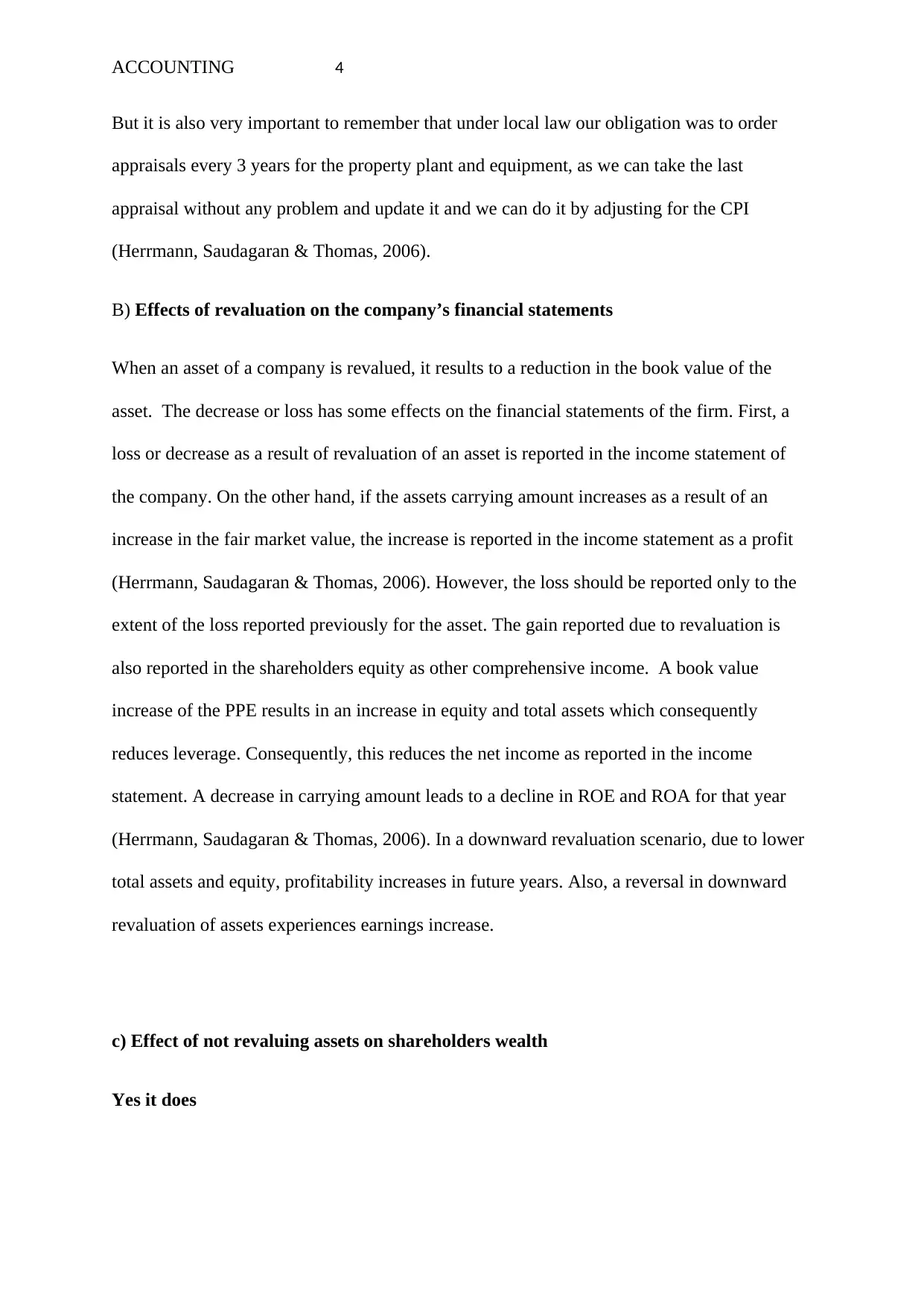
ACCOUNTING 4
But it is also very important to remember that under local law our obligation was to order
appraisals every 3 years for the property plant and equipment, as we can take the last
appraisal without any problem and update it and we can do it by adjusting for the CPI
(Herrmann, Saudagaran & Thomas, 2006).
B) Effects of revaluation on the company’s financial statements
When an asset of a company is revalued, it results to a reduction in the book value of the
asset. The decrease or loss has some effects on the financial statements of the firm. First, a
loss or decrease as a result of revaluation of an asset is reported in the income statement of
the company. On the other hand, if the assets carrying amount increases as a result of an
increase in the fair market value, the increase is reported in the income statement as a profit
(Herrmann, Saudagaran & Thomas, 2006). However, the loss should be reported only to the
extent of the loss reported previously for the asset. The gain reported due to revaluation is
also reported in the shareholders equity as other comprehensive income. A book value
increase of the PPE results in an increase in equity and total assets which consequently
reduces leverage. Consequently, this reduces the net income as reported in the income
statement. A decrease in carrying amount leads to a decline in ROE and ROA for that year
(Herrmann, Saudagaran & Thomas, 2006). In a downward revaluation scenario, due to lower
total assets and equity, profitability increases in future years. Also, a reversal in downward
revaluation of assets experiences earnings increase.
c) Effect of not revaluing assets on shareholders wealth
Yes it does
But it is also very important to remember that under local law our obligation was to order
appraisals every 3 years for the property plant and equipment, as we can take the last
appraisal without any problem and update it and we can do it by adjusting for the CPI
(Herrmann, Saudagaran & Thomas, 2006).
B) Effects of revaluation on the company’s financial statements
When an asset of a company is revalued, it results to a reduction in the book value of the
asset. The decrease or loss has some effects on the financial statements of the firm. First, a
loss or decrease as a result of revaluation of an asset is reported in the income statement of
the company. On the other hand, if the assets carrying amount increases as a result of an
increase in the fair market value, the increase is reported in the income statement as a profit
(Herrmann, Saudagaran & Thomas, 2006). However, the loss should be reported only to the
extent of the loss reported previously for the asset. The gain reported due to revaluation is
also reported in the shareholders equity as other comprehensive income. A book value
increase of the PPE results in an increase in equity and total assets which consequently
reduces leverage. Consequently, this reduces the net income as reported in the income
statement. A decrease in carrying amount leads to a decline in ROE and ROA for that year
(Herrmann, Saudagaran & Thomas, 2006). In a downward revaluation scenario, due to lower
total assets and equity, profitability increases in future years. Also, a reversal in downward
revaluation of assets experiences earnings increase.
c) Effect of not revaluing assets on shareholders wealth
Yes it does
Paraphrase This Document
Need a fresh take? Get an instant paraphrase of this document with our AI Paraphraser
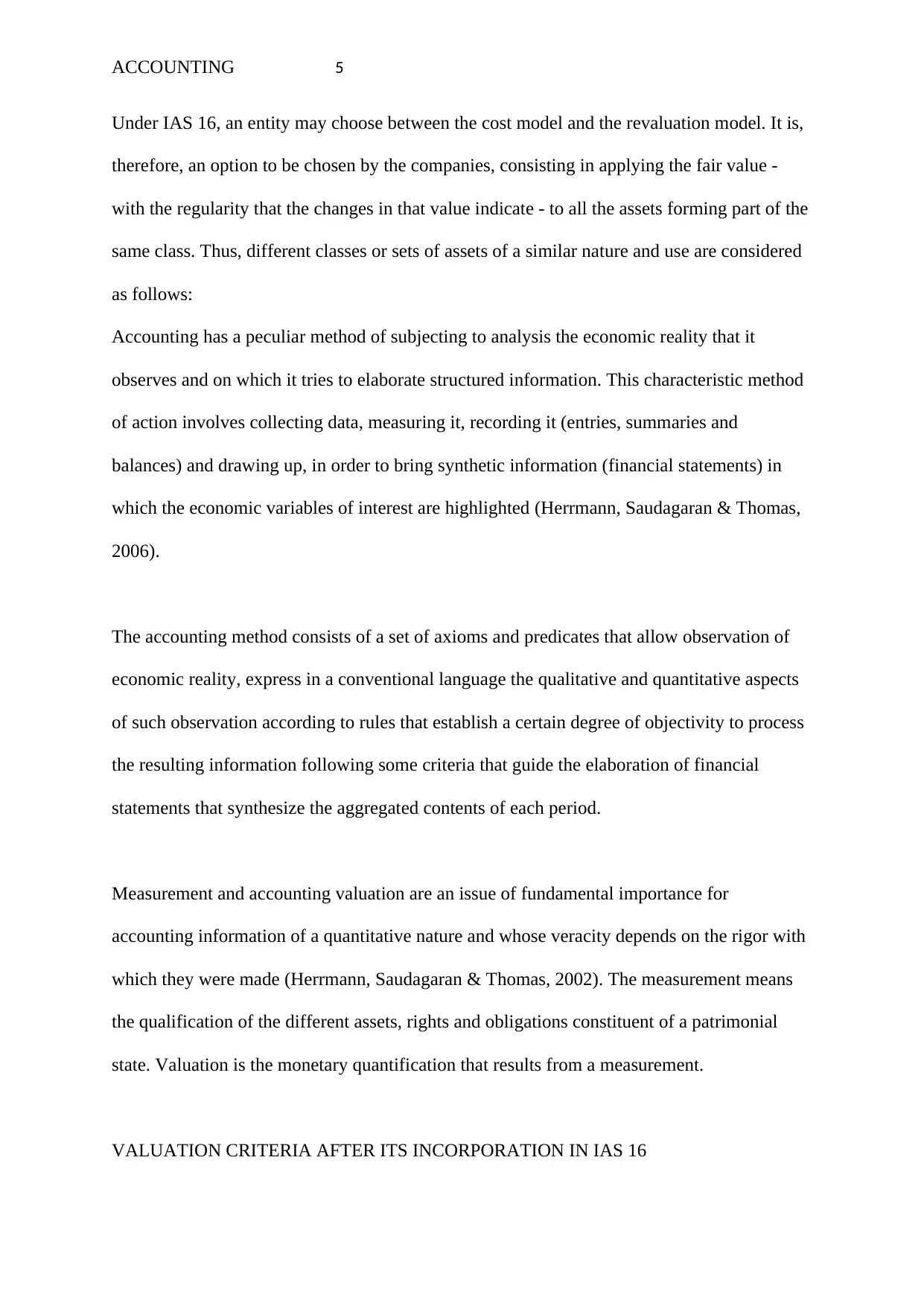
ACCOUNTING 5
Under IAS 16, an entity may choose between the cost model and the revaluation model. It is,
therefore, an option to be chosen by the companies, consisting in applying the fair value -
with the regularity that the changes in that value indicate - to all the assets forming part of the
same class. Thus, different classes or sets of assets of a similar nature and use are considered
as follows:
Accounting has a peculiar method of subjecting to analysis the economic reality that it
observes and on which it tries to elaborate structured information. This characteristic method
of action involves collecting data, measuring it, recording it (entries, summaries and
balances) and drawing up, in order to bring synthetic information (financial statements) in
which the economic variables of interest are highlighted (Herrmann, Saudagaran & Thomas,
2006).
The accounting method consists of a set of axioms and predicates that allow observation of
economic reality, express in a conventional language the qualitative and quantitative aspects
of such observation according to rules that establish a certain degree of objectivity to process
the resulting information following some criteria that guide the elaboration of financial
statements that synthesize the aggregated contents of each period.
Measurement and accounting valuation are an issue of fundamental importance for
accounting information of a quantitative nature and whose veracity depends on the rigor with
which they were made (Herrmann, Saudagaran & Thomas, 2002). The measurement means
the qualification of the different assets, rights and obligations constituent of a patrimonial
state. Valuation is the monetary quantification that results from a measurement.
VALUATION CRITERIA AFTER ITS INCORPORATION IN IAS 16
Under IAS 16, an entity may choose between the cost model and the revaluation model. It is,
therefore, an option to be chosen by the companies, consisting in applying the fair value -
with the regularity that the changes in that value indicate - to all the assets forming part of the
same class. Thus, different classes or sets of assets of a similar nature and use are considered
as follows:
Accounting has a peculiar method of subjecting to analysis the economic reality that it
observes and on which it tries to elaborate structured information. This characteristic method
of action involves collecting data, measuring it, recording it (entries, summaries and
balances) and drawing up, in order to bring synthetic information (financial statements) in
which the economic variables of interest are highlighted (Herrmann, Saudagaran & Thomas,
2006).
The accounting method consists of a set of axioms and predicates that allow observation of
economic reality, express in a conventional language the qualitative and quantitative aspects
of such observation according to rules that establish a certain degree of objectivity to process
the resulting information following some criteria that guide the elaboration of financial
statements that synthesize the aggregated contents of each period.
Measurement and accounting valuation are an issue of fundamental importance for
accounting information of a quantitative nature and whose veracity depends on the rigor with
which they were made (Herrmann, Saudagaran & Thomas, 2002). The measurement means
the qualification of the different assets, rights and obligations constituent of a patrimonial
state. Valuation is the monetary quantification that results from a measurement.
VALUATION CRITERIA AFTER ITS INCORPORATION IN IAS 16

ACCOUNTING 6
IAS 16 establishes two methods of valuation of Property, plant and equipment after their
initial recognition, considering the first option as preferred and the second as an alternative
treatment.
There are a number of situations that need to be resolved with respect to the valuation
methods discussed above, so we will first analyze the case of revaluations, continue with the
depreciations and end with the sale and disposal of property, plant and equipment (Herrmann,
Saudagaran & Thomas, 2002). IAS 16 adopts a post-valuation position from a general point
of view: Cost - Accumulated depreciation - the accumulated amount of any impairment loss
suffered, and another particular one: Revalued cost - accumulated depreciation - the
accumulated amount of any deterioration suffered (revaluation model).
The possibility of incorporating financial costs into the value of assets is one of the most
controversial aspects affecting the valuation of PPE elements. The problem is to analyze to
what extent the financial coverage that the company makes for the acquisition or manufacture
of the elements can affect the valuation of the same (Herrmann, Saudagaran & Thomas,
2006). This issue is important, since the proposed solution will not only affect the valuation
of the assets, but also the calculation of the result for the period, so that the bulk of the
accounting information that the company reveals will be made dependent on whether enables
the activation of financial charges through specific regulation (Herrmann, Saudagaran &
Thomas, 2006). This is compounded by the fact that in many cases companies have to
undertake large investments and do not have their own financing, which implies that they
IAS 16 establishes two methods of valuation of Property, plant and equipment after their
initial recognition, considering the first option as preferred and the second as an alternative
treatment.
There are a number of situations that need to be resolved with respect to the valuation
methods discussed above, so we will first analyze the case of revaluations, continue with the
depreciations and end with the sale and disposal of property, plant and equipment (Herrmann,
Saudagaran & Thomas, 2002). IAS 16 adopts a post-valuation position from a general point
of view: Cost - Accumulated depreciation - the accumulated amount of any impairment loss
suffered, and another particular one: Revalued cost - accumulated depreciation - the
accumulated amount of any deterioration suffered (revaluation model).
The possibility of incorporating financial costs into the value of assets is one of the most
controversial aspects affecting the valuation of PPE elements. The problem is to analyze to
what extent the financial coverage that the company makes for the acquisition or manufacture
of the elements can affect the valuation of the same (Herrmann, Saudagaran & Thomas,
2006). This issue is important, since the proposed solution will not only affect the valuation
of the assets, but also the calculation of the result for the period, so that the bulk of the
accounting information that the company reveals will be made dependent on whether enables
the activation of financial charges through specific regulation (Herrmann, Saudagaran &
Thomas, 2006). This is compounded by the fact that in many cases companies have to
undertake large investments and do not have their own financing, which implies that they
⊘ This is a preview!⊘
Do you want full access?
Subscribe today to unlock all pages.

Trusted by 1+ million students worldwide
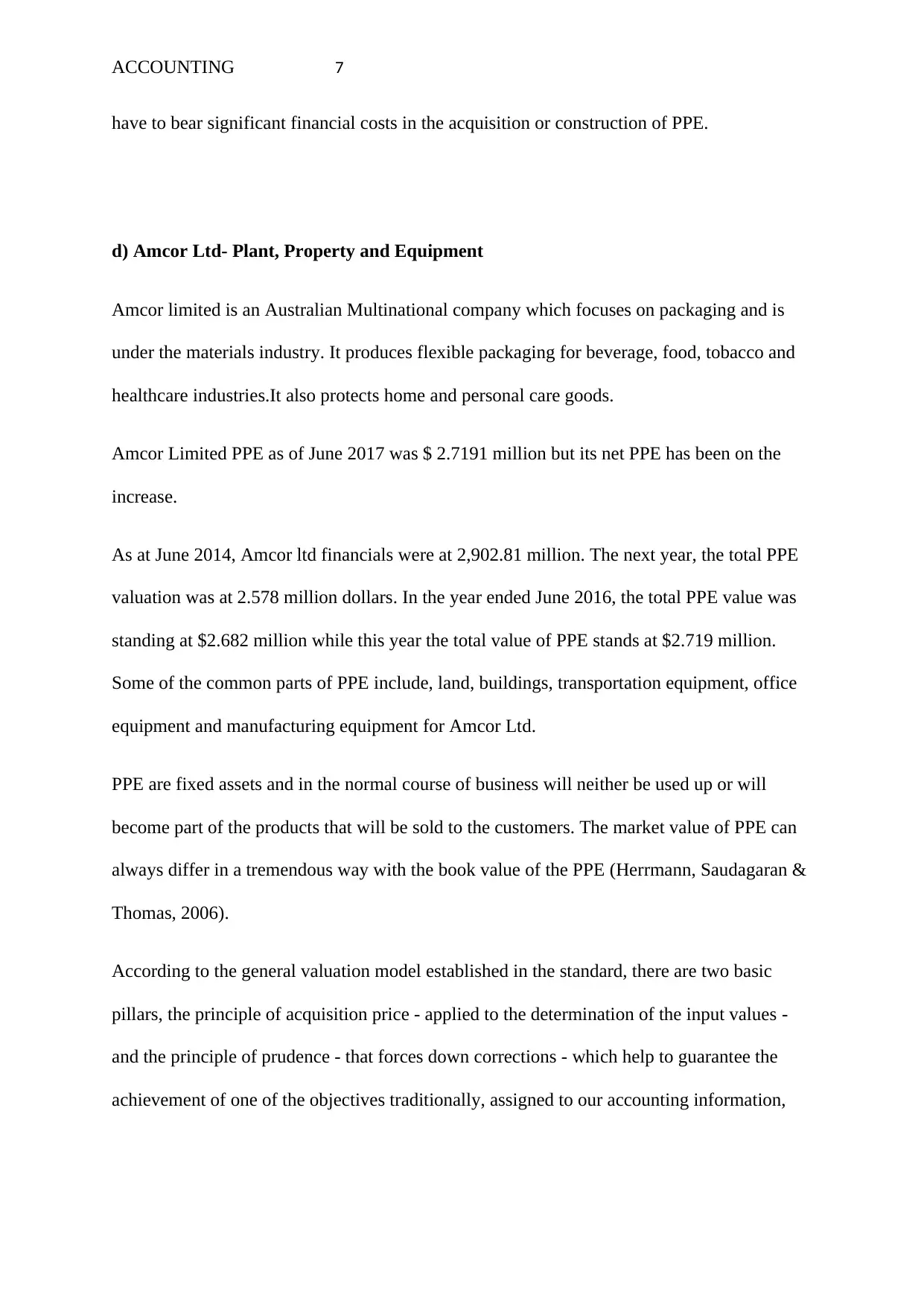
ACCOUNTING 7
have to bear significant financial costs in the acquisition or construction of PPE.
d) Amcor Ltd- Plant, Property and Equipment
Amcor limited is an Australian Multinational company which focuses on packaging and is
under the materials industry. It produces flexible packaging for beverage, food, tobacco and
healthcare industries.It also protects home and personal care goods.
Amcor Limited PPE as of June 2017 was $ 2.7191 million but its net PPE has been on the
increase.
As at June 2014, Amcor ltd financials were at 2,902.81 million. The next year, the total PPE
valuation was at 2.578 million dollars. In the year ended June 2016, the total PPE value was
standing at $2.682 million while this year the total value of PPE stands at $2.719 million.
Some of the common parts of PPE include, land, buildings, transportation equipment, office
equipment and manufacturing equipment for Amcor Ltd.
PPE are fixed assets and in the normal course of business will neither be used up or will
become part of the products that will be sold to the customers. The market value of PPE can
always differ in a tremendous way with the book value of the PPE (Herrmann, Saudagaran &
Thomas, 2006).
According to the general valuation model established in the standard, there are two basic
pillars, the principle of acquisition price - applied to the determination of the input values -
and the principle of prudence - that forces down corrections - which help to guarantee the
achievement of one of the objectives traditionally, assigned to our accounting information,
have to bear significant financial costs in the acquisition or construction of PPE.
d) Amcor Ltd- Plant, Property and Equipment
Amcor limited is an Australian Multinational company which focuses on packaging and is
under the materials industry. It produces flexible packaging for beverage, food, tobacco and
healthcare industries.It also protects home and personal care goods.
Amcor Limited PPE as of June 2017 was $ 2.7191 million but its net PPE has been on the
increase.
As at June 2014, Amcor ltd financials were at 2,902.81 million. The next year, the total PPE
valuation was at 2.578 million dollars. In the year ended June 2016, the total PPE value was
standing at $2.682 million while this year the total value of PPE stands at $2.719 million.
Some of the common parts of PPE include, land, buildings, transportation equipment, office
equipment and manufacturing equipment for Amcor Ltd.
PPE are fixed assets and in the normal course of business will neither be used up or will
become part of the products that will be sold to the customers. The market value of PPE can
always differ in a tremendous way with the book value of the PPE (Herrmann, Saudagaran &
Thomas, 2006).
According to the general valuation model established in the standard, there are two basic
pillars, the principle of acquisition price - applied to the determination of the input values -
and the principle of prudence - that forces down corrections - which help to guarantee the
achievement of one of the objectives traditionally, assigned to our accounting information,
Paraphrase This Document
Need a fresh take? Get an instant paraphrase of this document with our AI Paraphraser
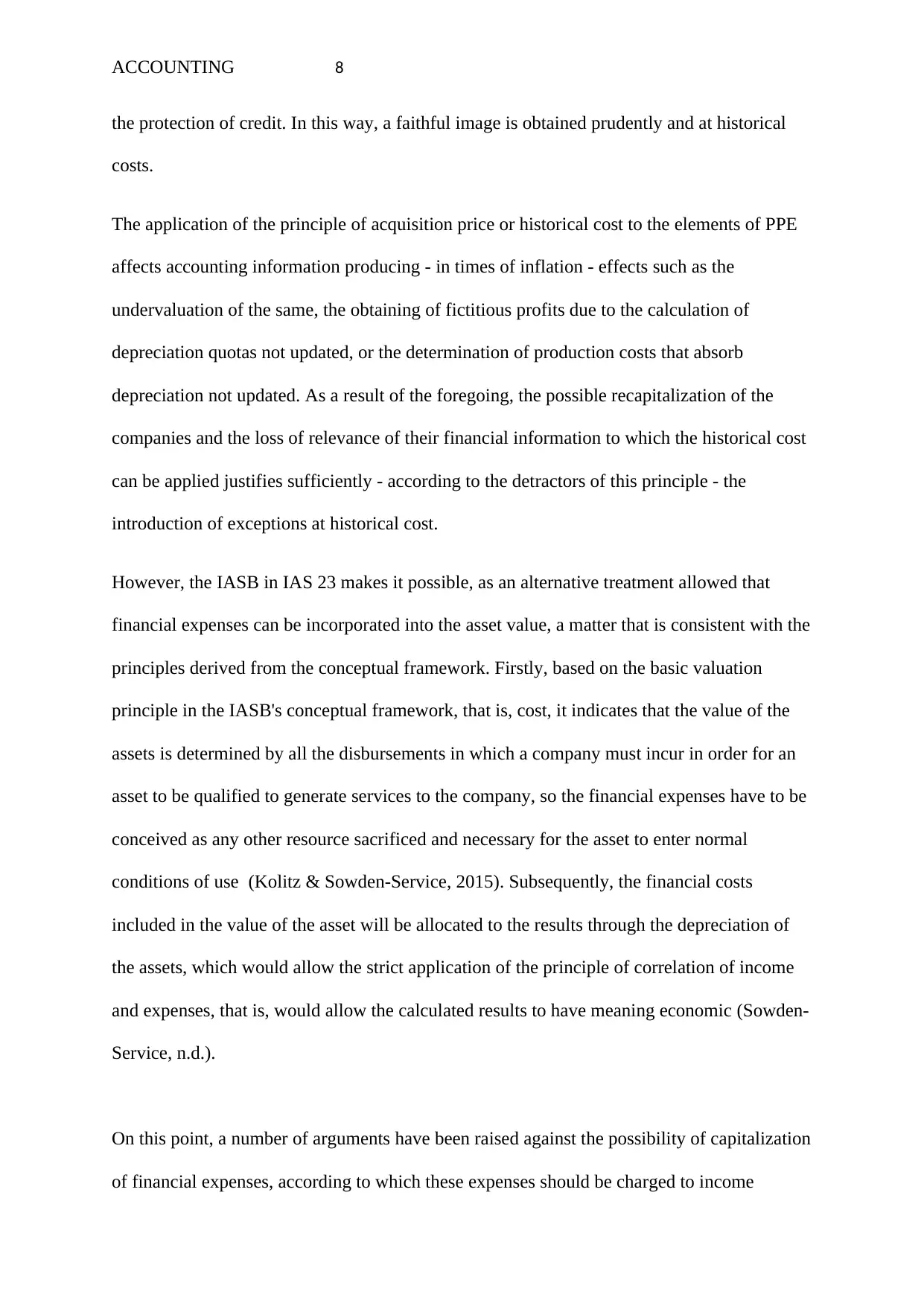
ACCOUNTING 8
the protection of credit. In this way, a faithful image is obtained prudently and at historical
costs.
The application of the principle of acquisition price or historical cost to the elements of PPE
affects accounting information producing - in times of inflation - effects such as the
undervaluation of the same, the obtaining of fictitious profits due to the calculation of
depreciation quotas not updated, or the determination of production costs that absorb
depreciation not updated. As a result of the foregoing, the possible recapitalization of the
companies and the loss of relevance of their financial information to which the historical cost
can be applied justifies sufficiently - according to the detractors of this principle - the
introduction of exceptions at historical cost.
However, the IASB in IAS 23 makes it possible, as an alternative treatment allowed that
financial expenses can be incorporated into the asset value, a matter that is consistent with the
principles derived from the conceptual framework. Firstly, based on the basic valuation
principle in the IASB's conceptual framework, that is, cost, it indicates that the value of the
assets is determined by all the disbursements in which a company must incur in order for an
asset to be qualified to generate services to the company, so the financial expenses have to be
conceived as any other resource sacrificed and necessary for the asset to enter normal
conditions of use (Kolitz & Sowden-Service, 2015). Subsequently, the financial costs
included in the value of the asset will be allocated to the results through the depreciation of
the assets, which would allow the strict application of the principle of correlation of income
and expenses, that is, would allow the calculated results to have meaning economic (Sowden-
Service, n.d.).
On this point, a number of arguments have been raised against the possibility of capitalization
of financial expenses, according to which these expenses should be charged to income
the protection of credit. In this way, a faithful image is obtained prudently and at historical
costs.
The application of the principle of acquisition price or historical cost to the elements of PPE
affects accounting information producing - in times of inflation - effects such as the
undervaluation of the same, the obtaining of fictitious profits due to the calculation of
depreciation quotas not updated, or the determination of production costs that absorb
depreciation not updated. As a result of the foregoing, the possible recapitalization of the
companies and the loss of relevance of their financial information to which the historical cost
can be applied justifies sufficiently - according to the detractors of this principle - the
introduction of exceptions at historical cost.
However, the IASB in IAS 23 makes it possible, as an alternative treatment allowed that
financial expenses can be incorporated into the asset value, a matter that is consistent with the
principles derived from the conceptual framework. Firstly, based on the basic valuation
principle in the IASB's conceptual framework, that is, cost, it indicates that the value of the
assets is determined by all the disbursements in which a company must incur in order for an
asset to be qualified to generate services to the company, so the financial expenses have to be
conceived as any other resource sacrificed and necessary for the asset to enter normal
conditions of use (Kolitz & Sowden-Service, 2015). Subsequently, the financial costs
included in the value of the asset will be allocated to the results through the depreciation of
the assets, which would allow the strict application of the principle of correlation of income
and expenses, that is, would allow the calculated results to have meaning economic (Sowden-
Service, n.d.).
On this point, a number of arguments have been raised against the possibility of capitalization
of financial expenses, according to which these expenses should be charged to income
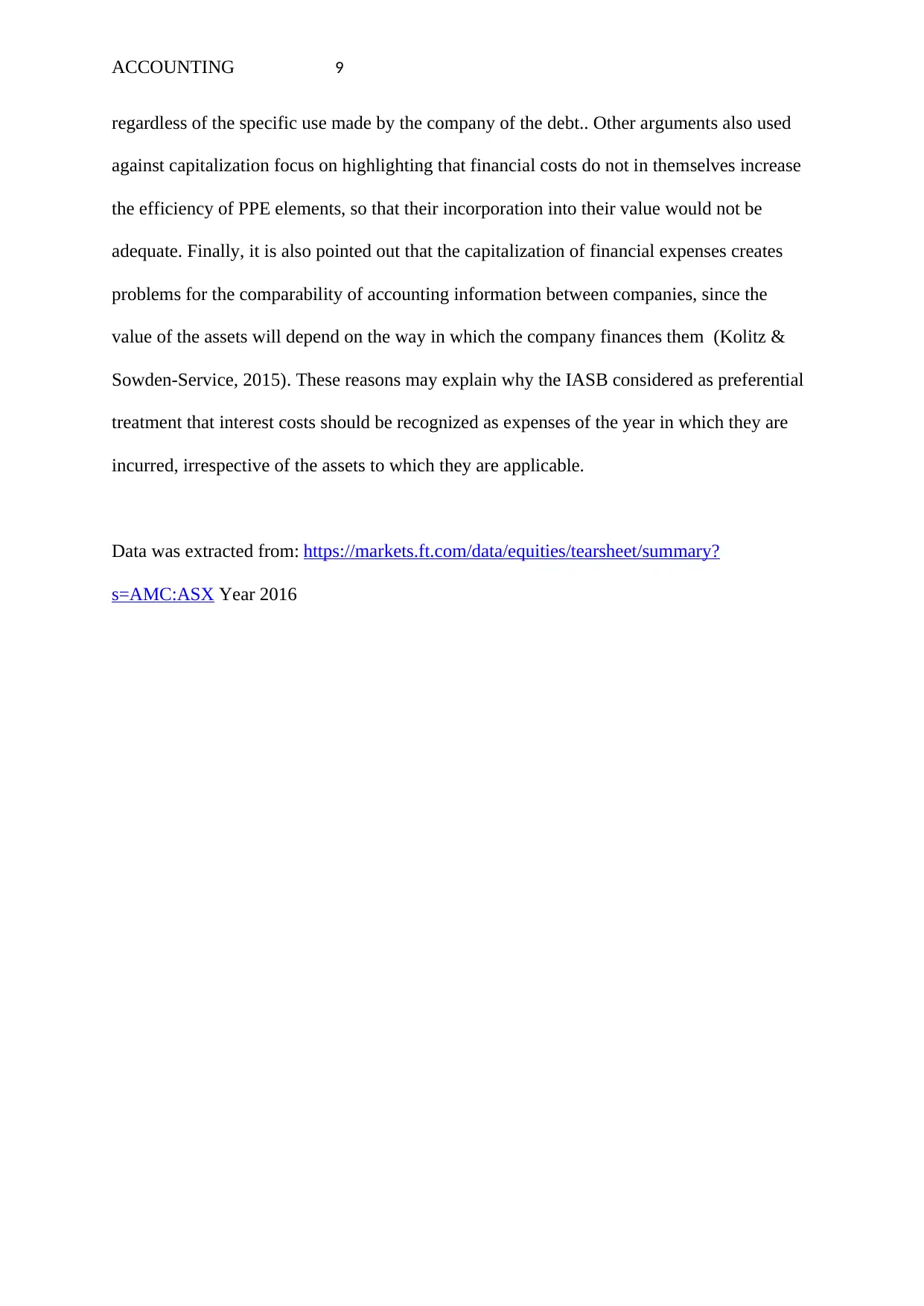
ACCOUNTING 9
regardless of the specific use made by the company of the debt.. Other arguments also used
against capitalization focus on highlighting that financial costs do not in themselves increase
the efficiency of PPE elements, so that their incorporation into their value would not be
adequate. Finally, it is also pointed out that the capitalization of financial expenses creates
problems for the comparability of accounting information between companies, since the
value of the assets will depend on the way in which the company finances them (Kolitz &
Sowden-Service, 2015). These reasons may explain why the IASB considered as preferential
treatment that interest costs should be recognized as expenses of the year in which they are
incurred, irrespective of the assets to which they are applicable.
Data was extracted from: https://markets.ft.com/data/equities/tearsheet/summary?
s=AMC:ASX Year 2016
regardless of the specific use made by the company of the debt.. Other arguments also used
against capitalization focus on highlighting that financial costs do not in themselves increase
the efficiency of PPE elements, so that their incorporation into their value would not be
adequate. Finally, it is also pointed out that the capitalization of financial expenses creates
problems for the comparability of accounting information between companies, since the
value of the assets will depend on the way in which the company finances them (Kolitz &
Sowden-Service, 2015). These reasons may explain why the IASB considered as preferential
treatment that interest costs should be recognized as expenses of the year in which they are
incurred, irrespective of the assets to which they are applicable.
Data was extracted from: https://markets.ft.com/data/equities/tearsheet/summary?
s=AMC:ASX Year 2016
⊘ This is a preview!⊘
Do you want full access?
Subscribe today to unlock all pages.

Trusted by 1+ million students worldwide
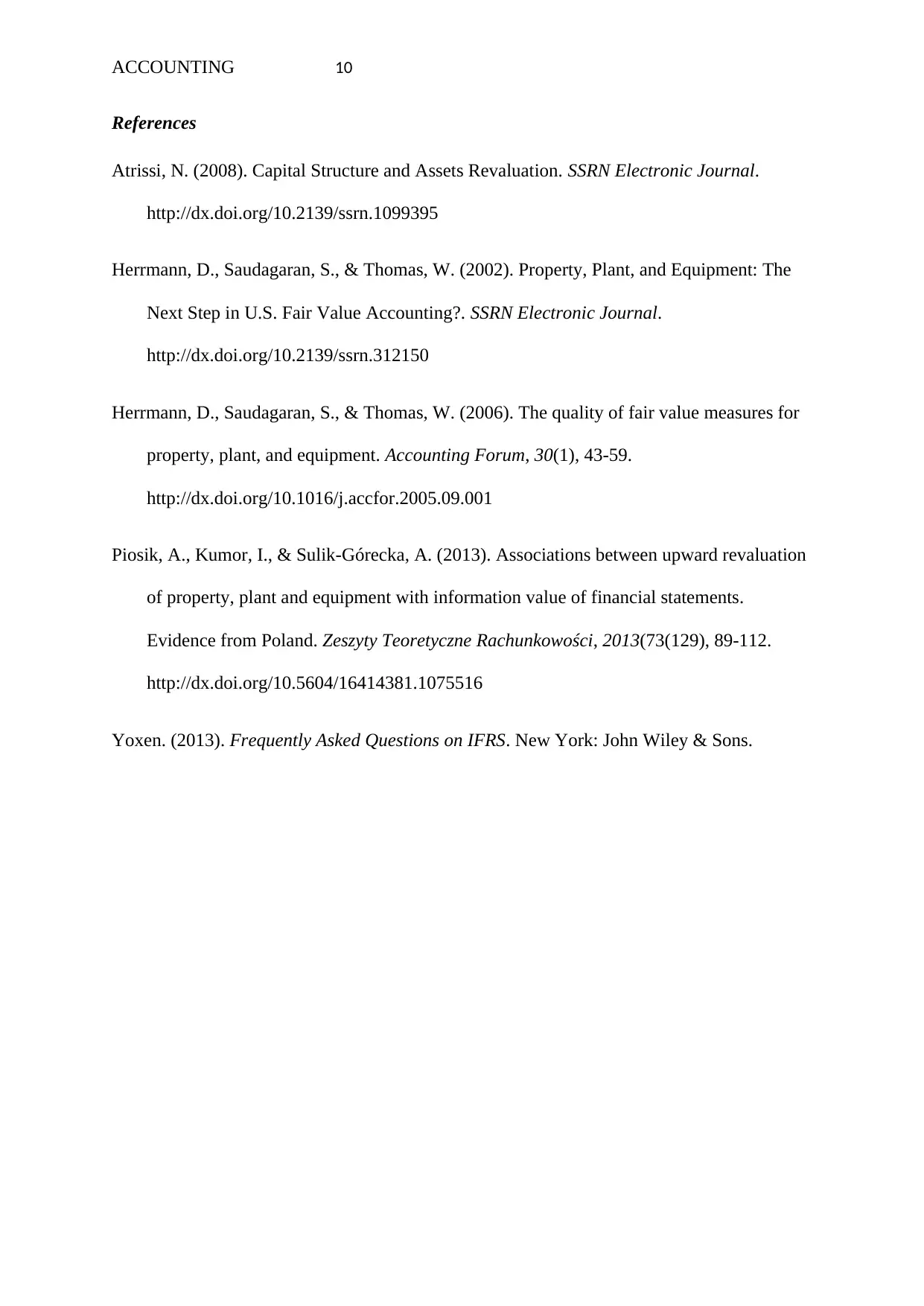
ACCOUNTING 10
References
Atrissi, N. (2008). Capital Structure and Assets Revaluation. SSRN Electronic Journal.
http://dx.doi.org/10.2139/ssrn.1099395
Herrmann, D., Saudagaran, S., & Thomas, W. (2002). Property, Plant, and Equipment: The
Next Step in U.S. Fair Value Accounting?. SSRN Electronic Journal.
http://dx.doi.org/10.2139/ssrn.312150
Herrmann, D., Saudagaran, S., & Thomas, W. (2006). The quality of fair value measures for
property, plant, and equipment. Accounting Forum, 30(1), 43-59.
http://dx.doi.org/10.1016/j.accfor.2005.09.001
Piosik, A., Kumor, I., & Sulik-Górecka, A. (2013). Associations between upward revaluation
of property, plant and equipment with information value of financial statements.
Evidence from Poland. Zeszyty Teoretyczne Rachunkowości, 2013(73(129), 89-112.
http://dx.doi.org/10.5604/16414381.1075516
Yoxen. (2013). Frequently Asked Questions on IFRS. New York: John Wiley & Sons.
References
Atrissi, N. (2008). Capital Structure and Assets Revaluation. SSRN Electronic Journal.
http://dx.doi.org/10.2139/ssrn.1099395
Herrmann, D., Saudagaran, S., & Thomas, W. (2002). Property, Plant, and Equipment: The
Next Step in U.S. Fair Value Accounting?. SSRN Electronic Journal.
http://dx.doi.org/10.2139/ssrn.312150
Herrmann, D., Saudagaran, S., & Thomas, W. (2006). The quality of fair value measures for
property, plant, and equipment. Accounting Forum, 30(1), 43-59.
http://dx.doi.org/10.1016/j.accfor.2005.09.001
Piosik, A., Kumor, I., & Sulik-Górecka, A. (2013). Associations between upward revaluation
of property, plant and equipment with information value of financial statements.
Evidence from Poland. Zeszyty Teoretyczne Rachunkowości, 2013(73(129), 89-112.
http://dx.doi.org/10.5604/16414381.1075516
Yoxen. (2013). Frequently Asked Questions on IFRS. New York: John Wiley & Sons.
1 out of 10
Related Documents
Your All-in-One AI-Powered Toolkit for Academic Success.
+13062052269
info@desklib.com
Available 24*7 on WhatsApp / Email
![[object Object]](/_next/static/media/star-bottom.7253800d.svg)
Unlock your academic potential
Copyright © 2020–2025 A2Z Services. All Rights Reserved. Developed and managed by ZUCOL.




